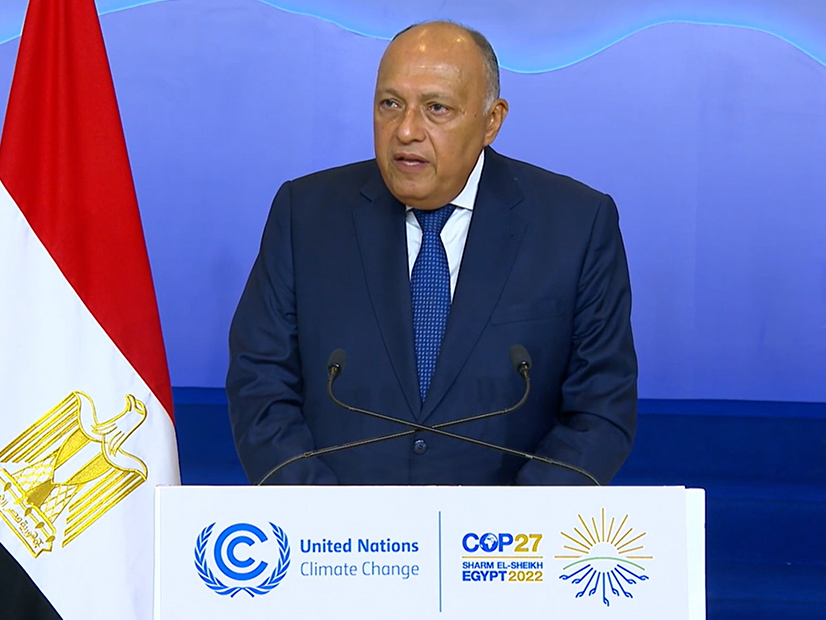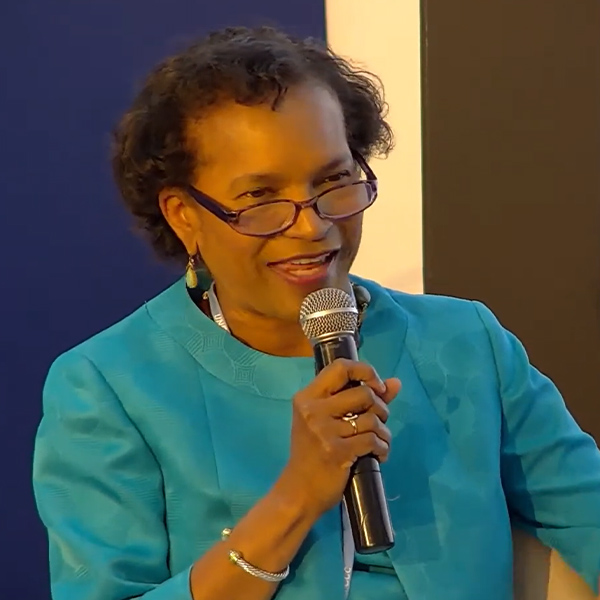
Federal buildings in Arkansas could, in the near future, be running on 100% carbon-free electricity (CFE), at least half of which would match the facilities’ demand hour for hour, 24/7, according to a new memorandum of understanding signed by the U.S. General Services Administration and Entergy, the state’s largest investor-owned utility.
The MOU was announced Tuesday at the 27th Conference of the Parties (COP27) in Sharm el-Sheikh, Egypt, in line with a new U.S.-led Net Zero Government initiative, with 18 other countries signing on to cut greenhouse gas emissions from their national government operations to net zero by 2050.
 Brenda Mallory, Council on Environmental Quality | U.S. Department of State
Brenda Mallory, Council on Environmental Quality | U.S. Department of StateThe countries have also each agreed to develop a roadmap for achieving their net-zero goals, including interim targets, and to publish this plan all before COP28 next year in the United Arab Emirates, according to Brenda Mallory, chair of the White House Council on Environmental Quality (CEQ). Australia, Austria, Belgium, Canada, Cyprus, Finland, France, Germany, Ireland, Israel, Japan, Korea, Lithuania, the Netherlands, New Zealand, Singapore, Switzerland and the U.K. are the founding members of the initiative, along with the U.S., Mallory said at a launch event on Thursday in Sharm el-Sheikh.
“By joining this initiative, countries are — for the first time on a global stage, in a unified fashion — explicitly articulating the leadership role of government in catalyzing economywide climate actions and supporting their countries’ achievement of broader climate targets,” she said.
“We know that national governments are frequently the largest employers, electricity consumers, vehicle fleet owners, real estate holders and purchasers of goods and services in their countries,” Mallory said. “As a result, efforts to green our government operations can spur demand for clean industries and technologies, accelerate innovation … and lower decarbonization costs across all sectors.”
Entergy is one of the federal government’s top 10 electricity suppliers, serving a federal load in Arkansas of about 241,000 MWh per year, spread over 3,485 federal facilities in the state, according to a GSA spokesperson.
The MOU calls for the GSA and Entergy to collaborate on a plan that would provide all the utility’s federal customers 100% renewable power or CFE by 2030, with 50% matching demand 24/7. Entergy’s existing nuclear plants — one each in Arkansas and Mississippi, and two in Louisiana — will be part of the mix, along with “regionally sourced” renewables, including solar, wind and hydropower, the agreement says.
Entergy and the federal government will also pick up all costs of developing and delivering the clean power, with no cost-shifting to other customers, who may eventually have access to the 100% clean power. The MOU specifically calls for the utility to design and file a CFE rate by the end of 2022, which “would provide the appropriate pricing and other terms” needed to meet the 100% clean electricity target.
According to a GSA press release, “once [the plan is] fully developed and approved, it is anticipated that Entergy Arkansas customers in both the public and private sector will have a cost-competitive and reliable option for CFE that matches their electricity consumption for all hours of the day.”
GSA Administrator Robin Carnahan said the MOU is a potential model for similar utility-government partnerships that will “spur demand for carbon pollution-free electricity — when and where people need it.” Other benefits include “helping to promote local, clean energy sources and catalyze utility-scale energy storage, and create a more resilient grid,” she said.
Entergy has not commented on the MOU.
Close of the COP
COP27 closed in the early hours of Sunday, with exhausted delegates approving a historic agreement establishing a structure and process for creating a fund to help developing nations build back from the loss and damage they have already experienced from extreme weather caused by climate change.
After years of opposing any action on loss and damage, the U.S. signaled it would sign on to the agreement, which also calls for developing a range of financing options for addressing loss and damage, for example, climate risk insurance. The agreement also does not set any targets or call for any commitments for funding from developed countries.
With the Republicans taking control of the House of Representatives in January, it is unlikely that President Biden would be able to get additional climate funding for loss and damage approved.
In a statement posted to Twitter, U.N. Secretary-General Antonio Guterres said the agreement in and of itself “would not be enough, but it is a much needed political signal to rebuild broken trust.”
At the same time, the lack of a strong commitments on accelerated emission reductions and the phasedown of fossil fuels in the final conference decision at COP27 left the goal of limiting global warming to 1.5 degrees Celsius still on “on life support,” according to COP26 President Alok Sharma, speaking at the closing plenary.
Measures that would have contributed to “emissions peaking before 2025 as science tells us is necessary, not in this text; clear follow-through on the phasedown of coal, not in this text; a clear commitment to phaseout of all fossil fuels, not in this text,” Sharma said.
These and other issues left unsettled in Sharm el-Sheikh underline the importance of international efforts like the Net Zero Government initiative.
‘Show It’s Doable’
Both the initiative and the GSA-Entergy MOU build on Biden’s own plan for cutting U.S. government emissions, as laid out in an executive order issued in December 2021. The order first set the 2030 target for all 300,000 federal buildings to run on 100% clean power, matching demand 24/7 50% of the time. (See Biden Calls for Federal Procurement of 100% Clean Energy by 2030.)
The order also spelled out Biden’s intention for the federal government to “lead by example” and catalyze both technological innovation and economic and job growth. In addition to its clean power target, the order also requires that all new light-duty vehicles bought for the federal fleet to be zero-emission by 2027, with zero-emission procurement for all new vehicles in the fleet by 2035. The federal fleet currently has about 600,000 vehicles.
Other emission0reduction goals in the order include
-
-
- for all federal government buildings: net-zero emissions by 2045, with an interim goal of a 50% reduction by 2032;
- for all federal government operations: net-zero by 2050, with an interim target of a 65% reduction by 2030; and
- for federal procurement: net-zero by 2050, via a “Buy Clean” policy that will promote the use of low-carbon construction materials and other low-carbon materials across the supply chain.
-
Other governments in the initiative are adopting similar goals and using their purchasing power to set examples and develop best practices for businesses, cities and schools.
Australia has adopted a stretch goal for its government operations to be net zero by 2030, said Christopher Bowen, the country’s minister for climate change and energy.
“I think it’s more important in terms of the example we set,” Bowen said during a panel at Thursday’s launch event. “If we’re asking companies to drive lower emissions; if we’re asking households to drive lower emissions, we have to set the example; … show it’s doable, show it’s possible.”
The Australian roadmap includes installing solar panels on all government buildings and converting existing power purchase agreements to renewable energy, he said.
From Ireland to Singapore
Eamon Ryan, Ireland’s minister for the environment, climate and communications, also pointed to governments’ ability to set budgets and policy as key drivers for emission reductions. An Post, Ireland’s state-owned postal service, started electrifying its vehicle fleet in 2019, beginning with delivery vehicles serving Dublin’s city center and then expanding to other cities across the country.
“Everyone thought that was crazy, but it actually worked,” Ryan said. More than half of the company’s fleet is now electric, according to the An Post website.
 Grace Fu, Singapore | U.S. Department of State
Grace Fu, Singapore | U.S. Department of StateResponding to the current energy crisis, the government has also decided to install solar panels on every school building in the country, he said. In addition to cutting the schools’ electric bills, the panels also can be used for “education, for each school to be able to monitor and see how this works,” Ryan said.
“Schools are the center of community, so if we can get it working there, we can spread this to the local shops, the local housing and so on,” he said.
Similarly, Grace Fu, Singapore’s minister for sustainability and the environment, said that while net-zero government initiatives are important, they can not only be top down. Singapore’s all-of-government approach includes “encouraging all our ministries in their outreach to the community to build in that [net zero] shift in mindset,” Fu said.
“We like every one of [our] employees to be our champion; to be a sustainability champion,” she said. “If every public sector employee is really going out there to lead the charge, I think we can really cause a wave of movement in Singapore.”


